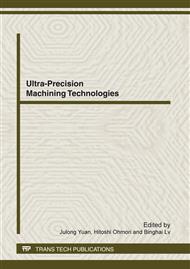p.10
p.15
p.20
p.25
p.30
p.35
p.41
p.46
p.56
Wear Mechanism of High-Speed Turning Ti-6Al-4V with TiAlN and AlTiN Coated Tools in Dry and MQL Conditions
Abstract:
The TiAlN and AlTiN coated carbide cutting tools were adopted for high-speed turning of α+β phase titanium alloy Ti-6Al-4V. Both the wear pattern and wear mechanism were investigated in this research. Results show that: MQL condition can greatly prolong the tool life of AlTiN coated carbide tool but has minor influence on improving the tool life of TiAlN carbide tool. AlTiN coated carbide tool was found to be qualified to obtain better cutting performance and longer tool life and is more suitable for processing titanium alloy TC4 compared with TiAlN coated tool under the same cutting parameters. In dry cutting condition, both adhesive and oxidation wear were observed to be the main wear types in these two coated carbide tools. However, in MQL condition, TiAlN coated tool may only suffer adhesive wear while the AlTiN coated carbide tool suffer adhesive, diffusion and oxidation wear.
Info:
Periodical:
Pages:
30-34
Citation:
Online since:
April 2012
Authors:
Keywords:
Price:
Сopyright:
© 2012 Trans Tech Publications Ltd. All Rights Reserved
Share:
Citation:


